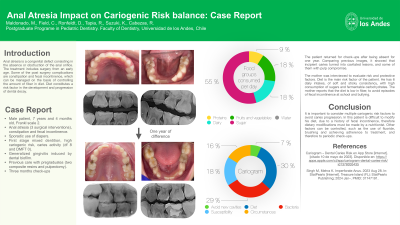Caries
525 - Anal Atresia Impact on Cariogenic Risk balance: Case Report


Monica V. Maldonado, DMS (she/her/hers)
Pediatric Postgraduate Student
Universidad de los Andes
Universidad de los Andes
Santiago, Region Metropolitana, Chile- CF
Carolina Field, DMD
Universidad de los Andes
- Dr
Daniela ronfeldt, DMD
Universidad de los Andes
- KS
Kiyoko Suzuki, DMD
Universidad de los Andes
- RT
Rebeca Tapia, DMD
Universidad de los Andes
- RC
Roxana Cabezas, -
Program Director
Universidad de Los Andes
Santiago, Region Metropolitana, Chile
Presenting Author(s)
Co-Author(s)
Program Director(s)
Introduction: anal atresia is a congenital defect consisting in the absence or obstruction of the anal orifice. The treatment includes surgery from an early age. Some of the post surgery complications are constipation and fecal incontinence, which can be managed on the basis of low or high fiber diet. In relation to this, diet constitutes a risk factor in the development of caries, so different types of diet are based on the complications of anal atresia, impacting the progression of caries.
Case Report: male patient, 7 years 4 months, Frankl 2, anorectal malformation, no sphincter control, high cariogenic risk. In the first instance, two composite resins were performed, including a pulpectomy. It is established to keep in control with fluoride therapy those incipient interproximal lesions, but with dental controls every three months. The patient was absent for one year and those incipient lesions turned into cavities and some with pulp compromise. Evaluating the risk and protective factors, it is identified that although the patient uses fluoride paste and coadjuvant elements, the diet plays a fundamental role. This is due to the fact that when the patient has fecal incontinence, the mother provides less high-fiber foods and more foods high in carbohydrates and sugars to avoid episodes of incontinence at school, affecting his relationship with his peers.

.jpg)